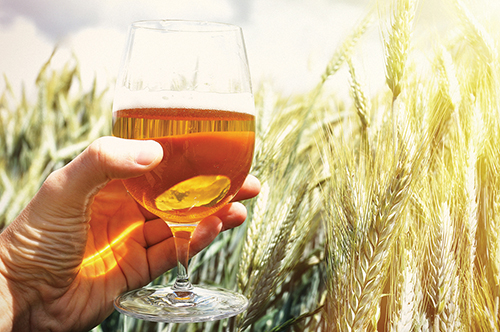
By Jack Kenny
These days a brewer has to produce an IPA to make a living. Not everyone, however, fancies a hoppy brew. The appeal of malt flavor is strong to certain palates, and has its place in a wide range of beer styles.
Malt is the reason beer exists. It was there before hops were used as a bittering agent. From malt comes carbon dioxide and alcohol, which is one good reason we drink the stuff. The flavor of malt is dominant in such styles as bock and doppelbock, English brown ales, Dortmunder export, some porters and stouts, and strong ales. Barley is, after all, a grain, and it satisfies in the way that bread and cereals give us pleasure.
Barley is the principal grain used in brewing. Others include wheat, oats and rye. Some beers make use of unmalted grains such as corn and rice. When the grain is allowed to germinate under controlled conditions, then dried in a kiln and sometimes roasted, it is known as malt. The malting process is necessary to make beer, because during germination certain enzymes are produced that convert the grain’s starch into sugar. Starches are large sugar molecules that have to be broken down in to smaller sugars that can be consumed by yeast later in the brewing process.
Heating malt in a kiln yields degrees of color, as well as flavor. The lightest malts, known as base malts, make up most of all beer recipes. Crystal malts, also called caramel malts, spend more time on the malting floor for higher production of sugars, which then are caramelized during kilning. These range from light to dark in color, with flavors that can range from mild to intense. Toasted malts spend more time in the kiln to produce yet more color and flavor, and roasted malts are kilned at high temperatures to shades ranging from brown to black.
What does malt taste like in beer? Esoteric questions such as this can be beyond my capability to answer, but I found an excellent description at aperfectpint.net: “Each type of malt brings its own particular set of flavors. Base malts are logically the most basic and give beer the most basic and grain-like flavors. Common descriptors would include grainy, corn, bready, saltine cracker, and husky. The crystal or caramel malts bring a range of caramelized sugar flavors. Common descriptors for these flavors include caramel, toffee, brown sugar, molasses, and burnt sugar. The darkest of these malts can impart rich dark fruit flavors like plum and prune.
“When maltsters toast malt the same chemical reactions occur as when you toast bread. The flavors of the toasted malts are correspondingly similar to those of toasted bread and include toast, biscuit, nutty, graham cracker and bread crust. The roasted malts are the darkest of the brewing grains and are responsible for the flavors associated with stouts and porters. They are kilned nearly to the point of becoming charred and have strong roasty and char flavors. Descriptors for these grains include roasted, burnt, smoky, chocolate, and coffee. The roasted grains also give beer bitterness like that found in a cup of espresso.”
Brown ales are malty. The northern English style, which includes Samuel Smith’s Nut Brown Ale and Newcastle Brown Ale, have gentle to moderate malt sweetness, with a nutty, light caramel character and a medium-dry to dry finish. The malt may also have a toasted, biscuity, or toffee-like character, according to the style notes at bjcp.org. Nothing can stop a brewer from giving a traditionally malty beer a stronger hop profile, but that is a personal choice and a departure from tradition.
Bock and doppelbock beers, both lagers, demand a high malt profile and low hops in the aroma and taste. Bocks lack caramel character, while doppelbocks, which are high in alcohol strength, have a dominant malty sweetness that stops short of cloying.
Porters and stouts, of which there are many, range from dry, lightly malted, low alcohol styles to sweet, rich, full-bodied brews with high strength. For a treat this season, try a good local Russian imperial stout: Charter Oak’s Lights Out Stout, eminently drinkable, quite strong, and a good lesson in the character and beauty of malted barley.
Jack Kenny has been writing The Beer Column for The Connecticut Beverage Journal since 1995. thebeercolumn@gmail.com




